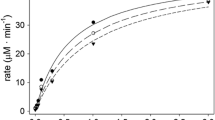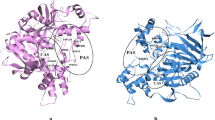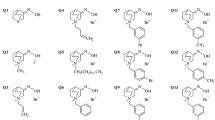Abstract
Phenyl valerate (PV) is a substrate for measuring the PVase activity of neuropathy target esterase (NTE), a key molecular event of organophosphorus-induced delayed neuropathy. A protein with PVase activity in chicken (model for delayed neurotoxicity) was identified as butyrylcholinesterase (BChE). Purified human butyrylcholinesterase (hBChE) showed PVase activity with a similar sensitivity to inhibitors as its cholinesterase (ChE) activity. Further kinetic and theoretical molecular simulation studies were performed. The kinetics did not fit classic competition models among substrates. Partially mixed inhibition was the best-fitting model to acetylthiocholine (AtCh) interacting with PVase activity. ChE activity showed substrate activation, and non-competitive inhibition was the best-fitting model to PV interacting with the non-activated enzyme and partial non-competitive inhibition was the best fitted model for PV interacting with the activated enzyme by excess of AtCh. The kinetic results suggest that other sites could be involved in those activities. From the theoretical docking analysis, we deduced other more favorable sites for binding PV related with Asn289 residue, situated far from the catalytic site (“PV-site”). Both substrates acethylcholine (ACh) and PV presented similar docking values in both the PV-site and catalytic site pockets, which explained some of the observed substrate interactions. Molecular dynamic simulations based on the theoretical structure of crystallized hBChE were performed. Molecular modeling studies suggested that PV has a higher potential for non-competitive inhibition, being also able to inhibit the hydrolysis of ACh through interactions with the PV-site. Further theoretical studies also suggested that PV could yet be able to promote competitive inhibition. We concluded that the kinetic and theoretical studies did not fit the simple classic competition among substrates, but were compatible with the interaction with two different binding sites.







Similar content being viewed by others
Abbreviations
- AtCh:
-
Acethylthiocholine
- ACh:
-
Acethylcholine
- AChE:
-
Acetylcholinesterase (in general of any specie)
- BChE:
-
Butyrylcholinesterase (in general of any specie)
- Ch:
-
Choline
- ChE:
-
Cholinesterase (the activity)
- hBChE:
-
Human butyrylcholinesterase
- MM-PBSA:
-
Molecular Mechanics Poisson Boltzman Solver Area
- NTE:
-
Neuropathy target esterase
- PV:
-
Phenyl valerate
- PVase:
-
Phenyl valerate esterase (the activity)
- PDB:
-
Protein data bank
References
Akaike H (1974) A new look at the statistical model identification. IEEE Trans Autom Control 19:716–723
Almeida JS, Guizado TR, Guimaraes AP, Ramalho TC, Goncalves AS, de Koning MC, Franca TC (2015) Docking and molecular dynamics studies of peripheral site ligand-oximes as reactivators of sarin-inhibited human acetylcholinesterase. J Biomol Struct Dyn 34:2632–2642
Azevedo LS, Moraes FP, Xavier MM, Pantoja EO, Villavicencio B, Finck JA, Proenca AM, Rocha KB, de Azevedo WF (2012) Recent progress of molecular docking simulations applied to development of drugs. Curr Bioinform 7(4):352–365
Baker NA, Sept D, Joseph S, Holst MJ, McCammon JA (2001) Electrostatics of nanosystems: application to microtubules and the ribosome. PNAS 98(18):10037–10041
Barril J, Estévez J, Escudero MA, Céspedes MV, Níguez N, Sogorb MA, Monroy A, Vilanova E (1999) Peripheral nerve soluble esterases are spontaneously reactivated after inhibition by paraoxon: implications for a new definition of neuropathy target esterase. Chem Biol Interact 119–120:541–550
Bastos L, da C, de Souza, Guimarães FR, Sirouspour AP, Guizado M, Forgione TRC, Ramalho P, França TC TCC (2016) Virtual screening, docking and dynamics of potential new inhibitors of dihydrofolate reductase from Yersinia pestis. J Biomol Struct Dyn 34:2184–2198
Bayly CI, Cieplak P, Cornell W, Kollman PA (1993) A well- behaved electrostatic potential based method using charge restraints for deriving atomic charges: the RESP model. J Phys Chem 97:10269–10280
Benabent M, Vilanova E, Sogorb MA, Estévez J (2014) Cholinesterase assay by an efficient fixed time endpoint method. MethodsX 1:258–263
Berman HM, Westbrook J, Feng Z, Gilliland G, Bhat TN, Weissig H, Shindyalov IN, Bourne PE (2000) The protein data bank. Nucleic Acids Res 28:235–242
Bosko JT, Todd BD, Sadus RJ (2005) Molecular simulation of dendrimers and their mixtures under shear: comparison of isothermal-isobaric (NpT) and isothermal-isochoric (NVT) ensemble systems. J Chem Phys 123(3):34905
Calamini B, Ratia K, Malkowski MG, Cuendet M, Pezuto JM, Santarsiero BD, Mesecar AD (2010) Pleiotropic mechanisms facilitated by resveratrol and its metabolites. Biochem J 429:273–282
Carrington CD, Abou-Donia MB (1984) The correlation between the recovery rate of neurotoxic esterase activity and sensitivity to organophosphorus-induced delayed neurotoxicity. Toxicol Appl Pharmacol 75(2):350–357
Céspedes MV, Escudero MA, Barril J, Sogorb MA, Vicedo JL, Vilanova E (1997) Discrimination of carboxylesterases of chicken neural tissue by inhibition with a neuropathic, non-neuropathic organophosphorus compounds and neuropathy promoter. Chem Biol Interact 106(3):191–200
Chemnitius JM, Haselmeyer KH, Zech R (1983) Neurotoxic esterase. Identification of two isoenzymes in hen brain. Arch Toxicol 53(3):235–244
Çokuğraş AN (2003) Butyrylcholinesterase: structure and physiological importance. Turk J Biochem 28(2):54–61
Cornell WD, Cieplak P, Bayly CI, Kollman PA (1993) Application of RESP charges to calculate conformational energies, hydrogen bond energies, and free energies of solvation. J Am Chem Soc 115:9620–9631
Cornish-Bowden A (2004) In principles of enzyme kinetics, 3rd edn. In: Cornish-Bowden A (ed) Portland Press, London, pp 36–39
de Souza FR, Guimarães AP, Cuya T, de Freitas MP, Gonçalves AS, Forgione P, França TC (2016) Analysis of Coxiela burnetti dihydrofolate reductase via in silico docking with inhibitors and molecular dynamics simulation. J Biomol Struct Dyn 1102:1–12
Escudero MA, Céspedes MV, Vilanova E (1997) Chromatographic discrimination of soluble neuropathy target esterase isoenzymes and related phenyl valerate esterases from chicken brain, spinal cord, and sciatic nerve. J Neurochem 68(5):2170–2176
Estévez J, García-Perez A, Barril J, Pellín MC, Vilanova E (2004) The inhibition of the high sensitive peripheral nerve soluble esterases by mipafox. A new mathematical processing for the kinetics of inhibition of esterases by organophosphorus compounds. Toxicol Lett 151:243–249
Estévez J, Barril J, Vilanova E (2010) Inhibition with spontaneous reactivation and the “ongoing inhibition” effect of esterases by biotinylated organophosphorus compounds: S9B as a model. Chem Biol Interact 187(1–3):397–402
Estévez J, García-Pérez A, Barril J, Vilanova E (2011) Inhibition with spontaneous reactivation of carboxyl esterases by organophosphorus compounds: paraoxon as a model. Chem Res Toxicol 24(1):135–143
Evans DJ, Holian BL (1985) The Nose-Hoover thermostat. J Chem Phys 83(8):4069–4074
Fišar Z, Hroudová J, Raboch J (2010) Inhibition of monoamine oxidase activity by antidepressants and moodstabilizers. Neuro Endocrinol Lett 31(5):645–656
Glynn P, Read DJ, Guo R, Wylie S, Johnson MK (1994) Synthesis and characterization of a biotinylated organophosphorus ester for detection and affinity purification of a brain serine esterase: neuropathy target esterase. Biochem J 301(2):551–556
Glynn P, Holton JL, Nolan CC, Read DJ, Brown L, Hubbard A, Cavanagh JB (1998) Neuropathy target esterase: immunolocalization to neuronal cell bodies and axons. Neuroscience 83(1):295–302
Guex N, Peitsch MC (1997) SWISS-MODEL and the Swiss-PdbViewer: an environment for comparative protein modeling. Electrophoresis 18:2714–2723
Harel M, Sussman JL, Krejci E, Bon S, Chanal P, Massoulié J, Silman I (1992) Conversion of acetylcholinesterase to butyrylcholinesterase: modeling and mutagenesis. Proc Natl Acad Sci USA 89:10827–10831
Hess B, Kutzner C, Van der Spoel D, Lindahl E (2008) GROMACS 4: algorithms for highly efficient, load-balanced, and scalable molecular simulation. J Chem Theory Comput 4:435–447
Homeyer N, Gohlke H (2012) Free energy calculations by the molecular mechanics poisson-boltzmann surface area method. Mol Inform 31(2):114–122
Hu Z, Jiang J (2009) Assessment of biomolecular force fields for molecular dynamics simulations in a protein crystal. J Comput Chem 31:371–380
Huang SY, Zou X (2010) Advances and challenges in protein-ligand docking. Int J Mol Sci 11:3016–3034
Jayaram B, Sprous D, Young MA, Beveridge DL (1998) Free energy analysis of the conformational preferences of A and B forms of DNA in solution. J Am Chem Soc 120(41):10629–10633
Johnson MK (1975) Structure-activity relationships for substrates and inhibitors of hen brain neurotoxic esterase. Biochem Pharmacol 24(7):797–805
Johnson MK (1977) Improved assay of neurotoxic esterase for screening organophosphates for delayed neurotoxicity potential. Arch Toxicol 37(2):113–115
Jorgensen WL, Chandrasekhar J, Madura JD, Impey RW, Klein ML (1983) Comparison of simple potential functions for simulating liquid water. J Chem Phys 79:926–935
Kar P, Lipowsky R, Knecht V (2013) Importance of polar solvation and configurational entropy for design of antiretroviral drugs targeting HIV-1 protease. J Phys Chem B 117(19):5793–5805
Kontoyanni M, McClellan LM, Sokol GS (2004) Evaluation of docking performance: comparative data on docking algorithms. J Med Chem 47:558–565
Kovarik Z, Radić Z, Berman HA, Simeon-Rudolf V, Reiner E, Taylor P (2003) Acetylcholinesterase active centre and gorge conformations analysed by combinatorial mutations and enantiomeric phosphonates. Biochem J 373:33–40
Kumari R, Kumar R, Open Source Drug Discovery Consortium, Lynn A (2014) g_mmpbsa—A GROMACS tool for high-throughput MM-PBSA calculations. J Chem Inf Model 54(7):1951–1962
Li XQ, Andersson TB, Ahlström M, Weidolf L (2004) Comparison of inhibitory effects of the proton pump-inhibiting drugs omeprazole, esomeprazole, lanso-prazole, pantoprazole and rabeprazole on human cytochrome P450 activities. Drug Metab Dispos 32:821–827
Mangas I, Vilanova E, Estévez J (2011) Kinetics of the inhibitory interaction of organophosphorus neuropathy inducers and non-inducers in soluble esterases in the avian nervous system. Toxicol Appl Pharmacol 256:360–368
Mangas I, Vilanova E, Estévez J (2012) Phenylmethylsulfonyl fluoride, a potentiator of neuropathy, alters the interaction of organophosphorus compounds with soluble brain esterases. Chem Res Toxicol 25(11):2393–2401
Mangas I, Radić Z, Taylor P, Ghassemian M, Candela H, Vilanova E, Estévez J (2017a) Butyrylcholinesterase identification in a phenylvalerate esterase-enriched fraction sensitive to low mipafox concentrations in chicken brain. Arch Toxicol 91(2):909–919
Mangas I, Vilanova E, Estévez J (2017b) Phenyl valerate esterase activity of human butyrylcholinesterase. Arch Toxicol 91:3295–3305
Martínez L, Borin IA, Skaf MS (2007) Fundamentos de Simulação por Dinâmica Molecular. In: Morgon NH, Coutinho K (eds) Métodos de Química Teórica e Modelagem Molecular. Editora Livraria da Física, São Paulo, pp 413–452 (ISBN: 9788588325876$4)
Masson P, Adkins S, Gouet P, Lockridge O (1993) Recombinant human butyrylcholinesterase G390V, the fluoride-2 variant, expressed in Chinese hamster ovary cells, is a low affinity variant. J Biol Chem 268(19):14329–14341
Masson P, Xie W, Froment MT, Levitsky V, Fortier PL, Albaret C, Lockridge O (1999) Interaction between the peripheral site residues of human butyrylcholinesterase, D70 and Y332, in binding and hydrolysis of substrates. Biochim Biophys Acta 1433(1–2):281–293
Masson P, Xie W, Froment MT, Lockridge O (2001) Effects of mutations of active site residues and amino acids interacting with the Omega loop on substrate activation of butyrylcholinesterase. Biochim Biophys Acta 1544(1–2):166–176
Nicolet Y, Lockridge O, Masson P, Fontecilla-Camps JC, Nachon F (2003) Crystal structure of human butyrylcholinesterase and of its complexes with substrate and products. J Biol Chem 278:41141–41147
Parrinello M, Rahman A (1981) Polymorphic transitions in single crystals: a new molecular dynamics method. J App Phys 52(12):7182–7190
Schwede T, Kopp J, Guex N, Peitsch MC (2003) SWISS-MODEL: an automated protein homology-modeling server. Nucleic Acids Res 31:3381–3385
Shao Y, Molnar LF, Jung Y, Kussmann J, Ochsenfeld C, Brown ST, Head-Gordon M (2006) Advances in methods and algorithms in a modern quantum chemistry program package. Phys Chem 8(27):3172–3191
Silva AWS, Vranken WF (2012) ACPYPE—AnteChamber PYthon Parser interfacE. BMC Res Notes 23:5:367
Sitkoff D, Sharp KA, Honig B (1994) Accurate calculation of hydration free energies using macroscopic solvent models. J Phys Chem 98(7):1978–1988
Suárez D, Field MJ (2005) Molecular dynamics simulations of human butyrylcholinesterase. Proteins 59:104–117
Suárez D, Díaz N, Fontecilla-Camps J, Field MJ (2006) A computational study of the deacylation mechanism of human butyrylcholinesterase. Biochemistry 45:7529–7543
Thomsen R, Christensen MH (2006) MolDock: a new technique for high-accuracy molecular docking. J Med Chem 49:3315–3321
Trott O, Olson AJ (2010) AutoDock Vina: improving the speed and accuracy of docking with a new scoring function, efficient optimization, and multithreading. J Comput Chem 31:455–461
Van der Spoel D, Lindahl E, Hess B, van Buuren AR, Apol E, Meulenhoff PJ, Tieleman DP, Sijbers ALTM, Feenstra KA, van Drunen R, Berendsen HJC (2005) GROMACS user manual version 3.3. http://www.gromacs.org. Accessed 12 Mar 2019
Vilanova E, Barril J, Carrera V, Pellin MC (1990) Soluble and particulate forms of the organophosphorus neuropathy target esterase in hen sciatic nerve. J Neurochem 55(4):1258–1265
Vorobjev YN, Almagro JC, Hermans J (1998) Discrimination between native and intentionally misfolded conformations of proteins: ES/IS, a new method for calculating conformational free energy that uses both dynamics simulations with an explicit solvent and an implicit solvent continuum model. Proteins 32(4):399–413
Wiesner J, Kříž Z, Kuča K, Jun D, Koča J (2010) Why acetylcholinesterase reactivators do not work in butyrylcholinesterase. J Enzyme Inhib Med Chem 25(3):318–322
Wong KKK, Ngo JC, Liu S, Lina H, Hu C, Shaw PC, Wan DC (2010) Interaction study of two diterpenes, cryptotanshinone and dihydrotanshinone,to human acetylcholinesterase and butyrylcholinesterase by molecular docking and kinetic analysis. Chem Biol Interact 187:335–339
Acknowledgements
We are most grateful to Dr. Douglas Cerasoli [USAMRICD (US Army Medical Research Institute of Chemical Defense), Aberdeen Proving Ground, MD, USA] for the supply of hBChE.
Funding
Work was partly supported by project “Mecanismos moleculares de toxicidad de xenobióticos” from the University Miguel Hernández of Elche (Spain), (Reference; 50AV0050RP). This work was supported by the Brazilian financial agencies CAPES (fellowships), CNPq (Grant No 306156/2015-6), FAPERJ (Grant No E-02/202.961/2017), and also the by the excellence project FIM.
Author information
Authors and Affiliations
Corresponding author
Additional information
Publisher’s Note
Springer Nature remains neutral with regard to jurisdictional claims in published maps and institutional affiliations.
Electronic supplementary material
Below is the link to the electronic supplementary material.
Rights and permissions
About this article
Cite this article
Estévez, J., Rodrigues de Souza, F., Romo, M. et al. Interactions of human butyrylcholinesterase with phenylvalerate and acetylthiocholine as substrates and inhibitors: kinetic and molecular modeling approaches. Arch Toxicol 93, 1281–1296 (2019). https://doi.org/10.1007/s00204-019-02423-8
Received:
Accepted:
Published:
Issue Date:
DOI: https://doi.org/10.1007/s00204-019-02423-8




